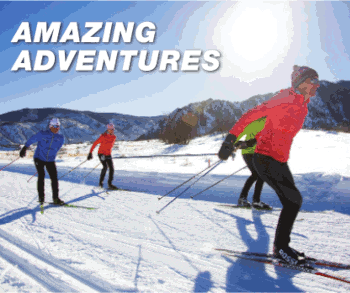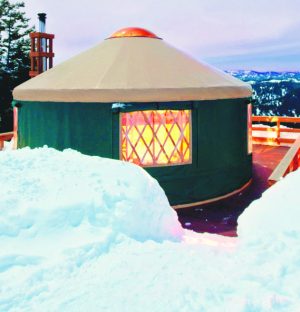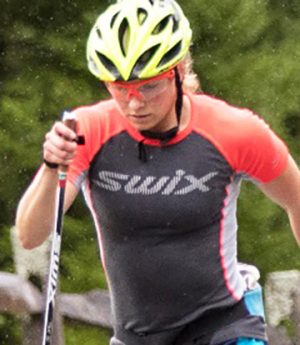 April 24, 2011 (Camrose, Alberta) – Irvin Servold has had a lifelong involvement in Nordic skiing, starting from his childhood in Camrose, Alberta. He began competing as a youngster and twice represented Canada in the Winter Olympic Games: 1956 (Cortina d’Ampezzo, Italy) and 1960 (Squaw Valley, California) in both cross country and Nordic combined.
April 24, 2011 (Camrose, Alberta) – Irvin Servold has had a lifelong involvement in Nordic skiing, starting from his childhood in Camrose, Alberta. He began competing as a youngster and twice represented Canada in the Winter Olympic Games: 1956 (Cortina d’Ampezzo, Italy) and 1960 (Squaw Valley, California) in both cross country and Nordic combined.
In the 1960s and 1970s, Irvin served for several years as chair of the Cross Country committee of the Canadian Ski Association (CSA), and later as chair of the Nordic Combined committee. He was also one of the founding members and long-time volunteers of Cross Country Alberta, known in its early days as the Alberta Ski Division. He fulfilled many roles in the organization, particularly that of Technical Chairman.
Irvin continues to be involved in Nordic skiing, both through his own efforts as a competitor and through his son Jon, who managed the jumping venue at the Vancouver Olympics in 2010. Irvin is a regular competitor in a variety of loppets in Alberta and B.C. each winter, and he also competes internationally every year in the Masters World Cup. – CCC
Memories of the Development of Skiing in Alberta
This is the story of the development of cross country skiing in Alberta, as I remember it.
In the early years, there was no Canadian Ski Association or Alberta Ski Division. Some of the earliest ski clubs in Canada were started in Montreal, Ottawa, Camrose, Edmonton, Banff and Revelstoke. These clubs, and others like them, were formed by newcomers to the country, often from Scandinavia, who brought their love of the sport with them, introducing cross country skiing, ski jumping and ski touring to Canadians. It was in these local clubs that the seeds for the future development of our sport were sown. As clubs matured, there was a need for well-regulated competitions and championships both locally and regionally and all of this became the driving force for the organization of the sport on a more formal level.
For me, it all began when my dad made me a pair of oak skis from old wooden barrels, which were common in those days in the early 1930s. The bindings consisted of a leather toe strap with a buckle into which I could slip my foot, so that the toe of my leather ankle-high school boots would extend far enough forward so that a rubber band – donated by my mother from her fruit preserving supplies – would stretch from the front of the toe strap to the back of the heel. My ski poles were made from small poplar trees, with a nail in the lower end and a piece of twine for the handle.
There were no formal competitions for youngsters when I started to ski. Most of the skiing activities were for trapping and general travel for fun along cow paths. We would go “hiking” on our skis, taking expeditions through the Stoney Creek Valley which ran through the town of Camrose, and challenging the hills on either side. All across the prairies, boys took the initiative to build their own small ski jumps (sometimes using a haystack!) and to organize impromptu Nordic combined ski tournaments, often assisted by the older Norwegian settlers. These tournaments were often part of a local winter carnival and prizes were always of a practical nature, such as a side of bacon or a sack of flour. The first prize I ever won was a jack knife.
A lot of old timer skiers lived in Camrose. Each Spring, the Norwegians would go on a ski hike – I remember watching them glide along the snow, taking long easy strides. I was amazed to see the older ladies also skiing effortlessly, wearing high boots which rose well over the ankles and were laced all the way to the top. The old timers’ skis were made of oak or hickory and the elite men often had a rat-trap type of Norwegian binding. A leather strap acted to adjust two levers together to hold down the boot edge. A more common type of binding was a steel side-iron which passed through the actual ski and came up on either side with a leather strap over the toe to hold the toe of the boot in place. Another leather strap passed round the heel of the boot and also attached to the steel side-iron. These bindings were known as “bergans” bindings.
It was great fun to join the old-timers on these Spring hikes down the valley. One of the more prominent of them was Paul Gotaas, who had won many of the Camrose races in the early days as well as the famous Lake Louise to Banff races. Camrose always sent a strong contingent of skiers to participate in the Banff Winter Carnival ski jumping event at the old Buffalo Hill Ski Jump. Another well-known Camrose skier was Jostein Nordmoe, who competed for Canada in Nordic Combined in the 1932 Winter Olympic Games in Lake Placid.
During the war years, cross country ski races became more formal and were hosted not only in Banff but also by the Edmonton Ski Club and the Camrose Ski Club, which also hosted jumping and nordic combined competitions. Probably the greatest impetus for the formation of an Alberta skiing identity were the Alberta High School Championships and the Banff International Collegiate Championships. Likewise, the Northern Alberta Ski Jumping Championships and the Camrose Annual Nordic Ski Competitions encouraged more people to compete. In Calgary, the Foothills Nordic Ski Club was started and eventually the Alberta Winter Games were devised.
Prior to the 1950s there was no Alberta Ski Division in the Canadian Ski Association. Rather, the Western Ski Division encompassed all of Canada west and north of the Ontario/Manitoba border. However, there were Eastern, Western and Canadian Championships held annually in various locations around the country. The National championships were usually dominated by the skiers from the region where the event was held each year, due to the difficulty and cost of travel for other skiers to get there. There were no government sports agencies, so all costs were borne by the skier or his club, although some times a local service club such as Rotary would sponsor a local competitor.
Gradually an Alberta skiing identity was formed, along with a growing responsibility for the development of the sport in the province. Representatives from various ski clubs, both Nordic and alpine, founded the Alberta Ski Division, with the major focus centering on club development. Standards were set for touring, touring instructors, competitions, technical requirements, team selection, training methods and the organization of a coaching programme. It was believed that if there was a solid foundation of organized clubs consisting mainly of recreational skiers, out of this would come the support to develop a strong competitive programme.
In the 1960s and 1970s, the national association established national standards for all levels of cross country skiing, giving the divisions a solid platform on which to base their activities. In Alberta, the Blue Lake Centre at Hinton hosted leadership development clinics for skiers from all over the province and enabled the development of several ski clubs. In preparation for the 1988 Olympic Winter Games in Calgary, the Alberta Ski Division held many officiating clinics to prepare the volunteers for the skiing events.
In the 21st century, sophisticated technical innovations in trail grooming and track setting along with electronic timing equipment, finish line cameras, audio-visual equipment, snow-making capabilities and many other advances have enhanced the sport of cross country skiing for recreational and competitive skiers alike. Today’s world is a far cry from the early days of cross country skiing not only in Alberta, but right across Canada and around the globe.
Skiing in Alberta has grown from its beginnings when skiers raced on a trail across a field, over fences, across railroad tracks and under bridges, encouraged by old men holding watches in their frozen hands, to the establishment of world-class facilities such as the Canmore Nordic Centre, where the 1988 Olympic Nordic competitions were held. Let us never forget those old timers and the gift they brought with them to Alberta when they settled here. The true concept of cross country skiing remains the same now as it was then: do the best we can, whenever we can, for the development of one of the best life-long sports in the world.






![National camp action [P]...](https://skitrax.com/wp-content/uploads/2019/08/Duluth-4-2019-08-08-at-10.46.51-AM-300x246.png)
![Matt Liebsch on the CXC Elite Team [P] CXC...](https://skitrax.com/wp-content/uploads/2019/08/Matt-Liebsch-CXC.2-525x700.4-300x267.jpg)
![Dan LaBlanc [P]...](https://skitrax.com/wp-content/uploads/2019/08/Dan-LaBlanc-img_1855.3.jpg)
